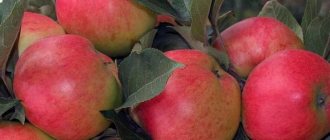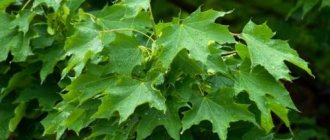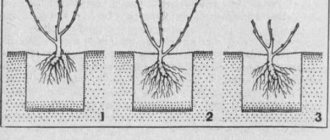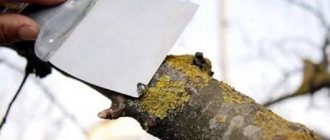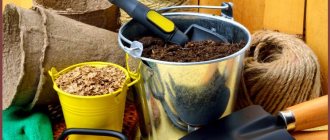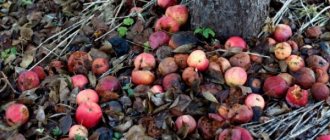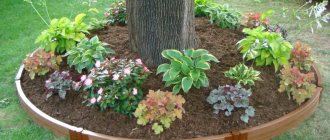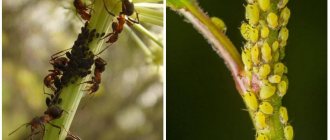An apple orchard full of trees and laden with fresh apples is quite a mesmerizing sight.
Creating such an orchard is a great idea for both a summer house and a personal yard.
But such a garden brings not only a generous amount of sweet apples, but also a lot of trouble. To reduce them, it is necessary to plant apple trees at a certain distance from each other and maintain a distance from other garden crops .
At what distance should apple trees be planted from each other?
Even on a limited area of “six acres” you can find the most favorable placement for all trees.
After all , the correct placement of fruit trees in personal orchards and orchards, including the distance between apple trees when planting, is one of the most important conditions in the system for obtaining excellent harvests, also aimed at maintaining apple trees in excellent health.
TIP: The planting pattern for apple trees always changes depending on the climate of the growing region and the size of the orchard.
How to properly care for an apple tree after planting
In the spring after planting, to stimulate the development of stems, the central shoot is cut into 2-3 buds. Subsequent stages of formation are carried out within a year after landing.
In the first year after planting they need regular watering.
Plants are watered immediately after planting. In summer, the tree trunk circle is irrigated 3–5 times depending on temperature conditions. The hotter the weather, the more the tree needs to be watered. If the apple tree grows in chernozem or loamy soil, it is enough to pour 7–15 liters of water under the seedling. In a sandy substrate, the need for moisture increases, so up to 20 liters of water are spent on one tree.
Important! After watering, loosen the soil in the tree trunk circle. Otherwise, the soil will form a crust and the root system will be poorly saturated with oxygen.
Taking into account the above recommendations, the gardener can easily determine the optimal scheme for planting apple trees. To do this, it is only important to know the varietal characteristics of the seedlings. By choosing the correct distance between trees, the plants will actively develop and begin to bear fruit successfully.
What if apple trees are on a dwarf rootstock?
Bush dwarf types of varieties have emerged relatively recently and currently they are often used when planting apple orchards of both micro and macro sizes.
It is recommended to plant them in one row with an inter-row spacing of 4.3 meters and at a distance of 2.2-2.7 meters from seedling to seedling, this is if the garden is small.
If the area is larger , then they are planted on trellises in rows. And in the inter-row space there should be at least 4.5 m, between trees - 2 m.
Planting rows of apple trees on a dwarf rootstock.
If “bush trees” are purchased, then determining at what distance to plant the apple tree from the apple tree will depend on the number of rows:
- In one line with a meter distance between the trees;
- Row from row - three meters.
Semi-dwarf and dwarf varieties are sometimes planted in “lines” with a gap of 2.5 m between them, interspersed with other garden crops.
If the garden has strict geometric shapes , then the apple trees should be planted taking into account a pre-worked plan, but even there they should not be planted closer than a meter to each other.
Even dwarf trees can create impenetrable thickets if they are planted with “neglect of distances.”
If the garden is more than 10 acres, then for dwarfs the distance between apple trees when planting is set:
- Between rows 3.5 m;
- Inside the row from 1.7 m to 2.6 m, in the presence of supporting structures.
If they grow without installing support, then:
- Between trees you need to leave 150-200 cm;
- There are four meters between the rows.
Planting dwarf trees
Planting of dwarf apple seedlings is carried out taking into account the following features of the garden:
- if the area allows, it is better to adhere to the planting plan in one row at a distance of 5 meters, so that at the exit the garden looks like a fruit wall;
- The second option for planting dwarf varieties involves maintaining a distance of 2 meters between each crop if the front garden area is small.
As for the distance between fruit rows, in both cases a distance of 4 meters should be maintained.
On a semi-dwarf rootstock
Semi-dwarf apple trees differ from dwarf apple trees in that they have greater crown growth power .
If, when planting an apple orchard, seedlings on a semi-dwarf rootstock or low-growing species , the grafting of which was carried out on the basis of seedlings, then the shortest distance should be at least three meters, and from row to row - approximately 5 meters.
If the size of the apple tree plantings is large, then it is necessary to plant using a “map” . This is when 10 rows are planted on an area of 50 by 100 meters, 5 meters between the rows, inside the trees themselves are placed at a distance of at least 375 cm, but it is better to focus on 400-450 cm.
Layout of columnar apple trees.
With this placement, further care will be simplified, and the garden will not turn into a forest over time .
When you need to plant no more than 10 semi-dwarf seedlings, the distance between the apple trees when planting is 4.5 meters between each other, and also between the rows. This will guarantee free and easy movement of gardening equipment around the site, and the owners themselves with their children.
If the varieties are vigorous , then the distance from apple tree to apple tree should be increased to five meters, but if they are not going to take special care of the garden, then 5.5 meters can be allocated. Since uncontrolled overgrowth of such trees is a very real thing.
Rules for planting and location of apple trees in the garden.
Start by assessing the area of the site, existing plantings and buildings, the level of soil acidity and the depth of groundwater. It is likely that your plot borders on a neighboring one, then it is important to know that according to the law, large trees are allowed to be placed at a distance of 3 m from the common fence, since a closer location may cause inconvenience to neighbors in the future. In your area, place trees at a distance of at least five meters from any buildings (from a house, barn, bathhouse or gazebo), since the structure creates shadow, and apple trees need not only enough space, but also a lot of sunlight.
Another important point is the absence of drafts, especially at first, while the tree is still young. Moreover, this will have a positive effect on the future harvest - in the absence of wind there will be more beneficial insects that are responsible for pollination.
Once you have decided on the location and are convinced that the groundwater is at a depth of more than two meters, you can begin preparing the site. In order to plant an apple tree in the spring, the hole must be prepared in the fall. If you are planning a fall planting, start preparing the hole three weeks before the expected date. Gardeners cannot come to a consensus on which planting is considered correct - spring or autumn. In the south of the country, apple trees are planted in the autumn, since autumn there is quite warm and the tree has time to take root well before winter, and when planted in spring, on the contrary, it can die in the hot summer. In cooler regions, on the contrary, it is recommended to plant in spring, then the seedling will have time to get stronger. It is better to avoid autumn planting, since a rainy autumn can very unexpectedly give way to frost.
If you decide to plant apple trees in the spring, then do it no earlier than the second half of April; the soil should have time to warm up. Well, if you prefer autumn planting, then analyze the climatic features of your area - the seedling should have time to take root before the first frost, and rooting will take at least a month. The shape of the hole for the apple tree does not matter; it can be either round (a meter in diameter and about 80 cm in depth) or square (all parameters are 80 cm). Carefully remove the top layer of soil (about thirty centimeters) and mix with nutrients (wood ash, humus or compost, phosphate fertilizers). Pour the resulting nutritious soil mixture to the bottom, but keep in mind that the root system of the apple tree should not directly touch the fertilizer.
If the soil on your site is clayey, then before filling the soil mixture, lay a drainage layer on the bottom (stones, broken bricks, gravel, expanded clay), and add coarse sand to the dense soil. On the contrary, clay can be added to sandy soil to achieve the desired soil condition. You don’t have to water the hole; the autumn rain will do it for you, thanks to which the soil will settle.
Inspect the root system of the seedling before planting - if you find damaged roots, they should be removed immediately. Then place a support at the bottom of the hole to which you will tie the apple tree, and then slightly loosen the soil at the bottom of the hole and place the seedling there. Straighten the roots; they should lie freely, without twisting or bending upward. Gradually cover them with soil, compacting it so that there are no air pockets left. After you have completely filled the hole, compact the soil again and make a small depression so that when watering the water does not spread away from the tree. Now you should water the seedling well and do this only with warm water. You will need 25-30 liters, but you need to pour them out not in one fell swoop, but gradually, waiting for the water to be absorbed. At first, apple tree seedlings need to be watered once every seven days, then it will be enough to do this once a month, but this should only be done with warm water. Most plants perceive cold water as frost, which means it will have a bad effect on the health and adaptation of the apple tree. But! Recommendations for watering apply only for spring planting; in the autumn, precipitation will be sufficient, and additional watering will not be required.
If your seedling is taller than 70 cm, then it needs to be trimmed a little. For a one-year-old apple tree, it is enough to trim the top, and for a two-year-old plant, the side branches are pruned; this is necessary for the correct formation of the tree.
You don’t have to worry about fertilizers for the first couple of years; the apple tree will only need what you put in the bottom of the hole.
What is the distance when planting apple trees in a checkerboard pattern?
In a checkerboard pattern , this is when trees in two parallel rows are planted in relation to the adjacent row with a shift. This placement contributes to better and more complete use of both the site area and the sun.
Experts from any nursery or large garden recommend the following planting:
- For dwarfs, you will need 150 cm in rows from each other;
- For semi-dwarf varieties: 300-375 cm apart;
- Large forms of apple trees on seed rootstocks will require 500-540 cm from each other.
Between the rows they leave from 3 meters when these are dwarf trees, and up to 5.5 meters for tall ones.
Also, a checkerboard planting order is often used in palmetto gardens “on supports” . In this case, the trees of the second row are planted so that they are opposite the empty space between the apple trees of the first row. Then you need 400 centimeters between rows and 200 centimeters between apple trees in a row.
ATTENTION! If the garden cannot be carefully looked after, then there is no point in using checkerboard planting, this will only worsen the existence of apple trees, since such planting will quickly turn the area into a “fruit forest.”
Features of drawing up a planting plan
Scheme for planting fruit trees
The plan for the future garden is drawn as a diagram on a sheet of paper. However, first a thorough study of the site is carried out. Windy and quiet places are determined using the observation method. The result is important when choosing varieties that tolerate and are afraid of drafts. If the terrain of the site is complex, moisture-loving crops are given space in the lowlands. Trees and shrubs that love dry soil are sent to higher ground.
It is optimal to plant low-growing trees closer to utility networks, your own buildings, and neighboring buildings, so that if they fall they will not damage the object.
When planning a garden, they try to allocate the northern part of the site for it. Tall trees with this arrangement will not shade the garden beds.
Advice! In the plan, it is important to correctly arrange crop groups according to ripening dates. It’s easier to collect the harvest in one place, rather than rushing around to different corners of the garden.
Depending on the size of the crown, the plantings are located relative to the cardinal directions:
- in the north tall trees are planted;
- to the south they are followed by plantings of medium height;
- low-growing, bushy berry gardens are located on the south side, dividing the garden and vegetable garden;
- The fourth level to the south is strawberries and garden crops.
What about when sitting in one row?
Often single-row planting or chain planting is used only to create fruit alleys from different fruit trees of two different species.
Or to create a “fruit wall” near a high neighbor’s fence . This planting is also good for small areas or for separating one part of a summer cottage from another.
If they want to arrange metal structures to form elaborate shapes , such as an arched vault, a fruit wall, then between the seedlings they keep the most minimal space than is usually accepted - from 150 to 200 centimeters.
When planting apple trees in the spring, the distance between a row of such trees and the rest of the garden or other structures of the dacha should be at least four meters and:
- If non-dwarf or spur trees are used, then between 250 and 300 centimeters should be left between the trunks
- If you are planting medium-sized varieties, you can choose a distance between apple trees of five meters in such a row.
- In a row of rapidly growing forms, it is customary to place trees at intervals of six meters.
TIP: It is not advisable to plant a row if it will “cut” the sun to the entire area. Otherwise, when the trees grow and rise to their full height, their shadow will make it impossible to use the area for garden vegetables.
Apple orchard project. Initial investment in an apple orchard as provided for in the business plan
To implement a project to create an intensive apple orchard, you will need an initial investment in the amount of 30 to 200 million rubles. as part of a business plan. Investments are made according to the following main items:
- Business registration – xxx rub.;
- Rent – xxx;
- Purchase and installation of equipment – xxx;
- Purchase of fertilizer and seedlings – xxx;
- Cash reserve – xxx.
You can use your own funds or receive additional financing in the form of bank loans, investments or subsidies from the state. In all cases, you will need a professionally written business plan. We created a ready-made business plan for an intensive apple orchard, where we structured all the information and made calculations. It is available for download from the link below.
Apple growing technology in a business plan
Creating an apple orchard as part of a business plan involves going through the following main stages:
- Prepare the soil by clearing the area, loosening the soil and applying fertilizer.
- Plant seedlings in late autumn or early spring. Here you will need to dig a hole and install dwarf rootstocks.
- Install a drip irrigation system to organize access of water to the roots.
- After this, during the growing process, a special crown trimming technology is used; the crown is formed by installing supports.
- Trees are treated with special preparations against pests and insects.
- The harvest is harvested by hand and sent to a warehouse for subsequent sale.
Purchase of equipment provided for in the business plan for an apple orchard
The business plan includes expenses for the purchase of the following equipment for the apple orchard:
- Mounted drill;
- Drip irrigation system;
- Tractor;
- Truck for transportation;
- Sprayer;
- Stolbostav;
- Mower;
- Computers and office furniture;
- Alarm system, ventilation and
Special equipment for storing fruits is not required, but it is necessary to select a room so that the temperature in it is maintained at 0°C.You would need a similar level of investment to start a walnut orchard. A nut orchard business plan for growing nuts will allow you to evaluate this idea as well. Nuts are currently mainly imported, but the climate allows many types of nuts to be grown in the Russian Federation.
At what distance should apple trees be planted depending on their growth vigor?
It is allowed to plant apple trees at such a distance that when they grow up, they fill the space of the garden in all directions and do not interfere with anyone with their growth.
The final height of a tree at maturity determines the space needed between trees in a row and between rows.
The lower the mature height of the trees being planted, the less space they will take up in the garden.
Rules for planting vigorous trees.
This way dwarf and super dwarf apple trees can grow closer to each other. It is also worth noting that trees grown on dwarf and superdwarf rootstocks are easier to “adapt” to a trellis.
Apple orchard planting scheme
Even in the minds of any gardener, the planting pattern of a columnar apple tree seems somehow dense - different from an ordinary apple tree. How dense?
Conclusions on a piece of paper could not answer this question. On the contrary, our practical work on studying the columnar apple tree and identifying its biological characteristics in the period 1990–2001. helped us formulate the concept of a super-dense columnar garden. Thus, we were able to evaluate in practice 12 different plant placement schemes, from super-dense - 0.5 x 0.5 m (40,000 plants per hectare) to schemes close to super-intensive gardens: 2.5 x 1.5 m (2,670 plants per hectare). All experiments showed and confirmed that the yield in the early years was mainly determined by the density of plants. At the first stage, very dense (50 x 50 cm) patterns won, but as the garden thickened, marketability sharply decreased and conditions for spraying and harvesting became more difficult. Therefore, such schemes were rejected.
As a result of the analysis of these experiments, an understanding was formed of what the columnar garden of the future should and could be. According to our data, the most rational system is multi-line blocks with a distance between plants of 40 cm, between rows of 1 m and a transverse passage between blocks of 2.5–3 m (technological passages that allow spraying, harvesting and removal of crops). Such placement schemes were repeatedly implemented in further experiments conducted by us on the basis of NPF Donskoy Nursery LLC. With this placement scheme, about 20,000 seedlings are needed per hectare.
Low growing apple trees
A 'gnome' or 'bush apple' apple tree will grow up to 3m tall and wide.
If you need to plant dwarf or spur forms in the garden, one and a half meters between apple trees and 2.5 m between rows will be enough for them.
When a large number of dwarfs are planted with a special support system, super-intensive planting is used. Trees of similar types are usually planted as well-developed two-year-old trees.
In the row, the gaps between the stems are 75 centimeters, and 4 meters must be left between the rows. After all, dwarf trees are not as hardy as standard trees, and grow best in moderately frosty winters under an agrofibre cover, so such trees are easier to cover.
- For classic low-growing varieties, but grafted onto seedlings and growing in the southern gardening zone, the shortest distance between rows of apple trees will be five meters, and within a row - about two meters.
- A farm version of a garden of low-growing apple trees is when there is a meter between dwarf apple trees in one row, and four meters between the rows;
- And low-growing seedlings should have 2.5 m, and five meters between rows.
Methods for planting apple trees
Planting apple trees in a checkerboard pattern
Such placement of trees contributes to a fuller and better use of not only the site, but also the sun. Gardeners recommend the following distance between apple trees when planting a garden:
- Dwarf varieties - about 1.5 m between seedlings.
- Semi-dwarf apple trees - at a distance of 3-3.75 m from each other.
- Vigorous apple trees on seed rootstocks - between trees from 5 to 5.5 m.
Row spacing:
- dwarf trees – from 3 m;
- tall trees - up to 5.5 m.
Also, a staggered planting arrangement is often used in gardens “on supports”. The second row of trees is planted opposite the free space between the seedlings of the first row. Row spacing is 4 m, between apple trees in a row is 2 m.
Planting apple trees in one row
As a rule, single-row planting is used to create alleys of fruit trees of two different species or to plant a “fruit wall” along a neighbor’s fence. In addition, this arrangement is excellent for small plots and for dividing parts of a summer cottage. For arranging metal structures when forming an arched vault or an apple tree wall, the distance is kept to a minimum - from 1.5-2 m.
If apple trees are planted in spring, the distance between the trees is as follows: There should be a gap of at least 4 m between the row of trees and the garden or structures. 2.5-3 m are left between dwarf seedlings. For medium-sized varieties, the distance between apple trees and pears when planting is - 5 m. Vigorous forms of trees are usually placed every 6 m.
Apple trees are planted so that when they grow older they fill the entire space of the garden and at the same time do not interfere with anyone with their growth. The required distance between rows and within a row depends on the final height of the mature apple tree. The lower the tree, the less space it will take up in the garden. For example, dwarf varieties can grow close together.
Low growing apple trees
Dwarf and shrub trees grow up to 3 m in height and width. For them, 1.5 m from each other and 2.5 m between the rows will be enough. If a large number of low-growing apple trees are planted with a special support system, then more intensive planting is used.
Classic low-growing varieties, grafted onto seedlings and growing in the southern zone, are planted at a distance of 5 m between the ranks and 2 m inside the row. Gardeners plant low-growing apple trees as follows:
- between dwarf trees - 1 m, and between rows - 4 m;
- between weak-growing seedlings - 2.5 m, and row spacing - 5 m.
Medium-sized apple trees
The standard height of medium-sized trees with improper pruning is up to 6 m and width up to 4-5 m. If apple trees are pruned, a distance of 5 m is made between rows, 3.7-4.5 m between seedlings. Medium-sized trees grafted onto seed rootstocks cut in the shape of a “cup”, they are planted, as a rule, in a checkerboard pattern at a distance of 6 m both in rows and between them. This provides apple trees with a comfortable life and easy care for gardeners. If seedlings of medium-sized forms are placed in a small area, the trees will have to be frequently and painstakingly pruned, otherwise the garden will turn into an impenetrable forest.
tall trees
If, in addition to seedlings, there are no more seedlings, then only their correct planting can provide the gardener with a bountiful harvest of apples. Previously, it was believed that in order to obtain adequate lighting, trees should be located far from each other (up to 9-13 m between apple trees). Since the height of apple trees can reach up to 8-11 m, if they are not pruned, they should be planted scattered at a distance of 9 -12 m. If tall trees are pruned, they will grow no more than 5 m. It is recommended to plant them in a checkerboard pattern with 7 m between seedlings. Particular attention should be paid to columnar varieties. They are also divided into semi-dwarf, dwarf and vigorous. How to plant columnar apple trees? The distance between dwarf apple trees is from 70 cm. For the other two species, planting at a distance of more than 2 m is best.
Medium-sized apple trees
If a summer resident wants to plant a garden of medium-sized forms, then a standard-sized medium-sized tree grows up to 6 meters in height. And if it is not pruned correctly, it will grow up to 4-5 meters wide. That is why medium-sized apple trees are usually reduced by pruning to 5 meters in height .
If the trees are pruned, the rows in the garden should be planted 5 meters apart from the row, and the trees should be 370 to 450 centimeters apart from each other.
When trees are pruned in the shape of a “cup ,” then such medium-sized trees, very often grafted onto seed rootstocks, must be planted in a checkerboard pattern at the same distance of 600 centimeters, both in rows and between them.
Free planting of medium-sized apple trees.
This will provide the apple trees with a comfortable life, and the gardener with easy care for such an apple orchard.
If it is necessary to plant seedlings of medium-sized forms in a small space of a summer cottage, then these trees require frequent and painstaking pruning, because if they are grown almost without pruning, they turn the garden into an impenetrable forest.
Important! And in order to properly care for the crown and harvest, the intervals of free space around the tree from surrounding trees should be within four meters, and between trees and buildings - 6.5 meters.
Distance from buildings and fences
Often, when planting seedlings, gardeners maintain the minimum permissible distance between crops, but at the same time do not take into account the required distance from fences and permanent buildings.
Regardless of the future size of adult apple trees, young trees should be planted at least 3 m from fences and 5 m from various buildings. Such requirements are due to the shadow created by objects, which negatively affects the growth and development of trees and significantly reduces their productivity. In addition, the root system in the process of its development causes damage to the foundation of the house.
tall trees
If there are no seedlings other than seed stocks, then only proper planting will provide the gardener with apples.
to plant far enough from the tree so that they have space to receive full sunlight, 9 meters and even 13 meters between apple trees.
Illumination of trees.
But it turned out that such a distance between trees does not coincide with the biological characteristics of either the species or any variety, and is also unsuitable for the climatic conditions of the area.
If the size of apple trees can be up to 8-11 meters in height, if they are not pruned in any way, they should be planted in a spread of 9 to 12.5 meters.
If standard tall apple trees are pruned and their height does not exceed five meters, then for such apple trees the best planting would be in a checkerboard pattern, seven meters between apple trees .
The tall seed apple trees themselves, as they are very hardy, are used for planting gardens in very cold regions, where frosts in winter are no more than -28 , then they need to be planted more densely.
So, if for Non-Black Earth gardens the garden is planted according to the scheme of 4.5 meters between trees and 5.5 between “lines”, but if the garden is mechanized , then the row spacing is “widened” to 6-7 meters.
And in the southern regions of the Russian Federation, it is recommended to plant apple trees on seed rootstocks 10 x 10 meters, but in a checkerboard pattern.
Intensive apple orchard. Intensive apple orchards - technology of the present and future
Apple is the most popular fruit growing in central Russia. Despite this, until recently, the bulk of apples sold on the Russian market, especially in winter, were imported from Poland, Serbia, and Turkey. Polish apples had an almost monopoly position.
However, the situation changed after 2014, when Russia introduced retaliatory sanctions against Europe. Polish fruits disappeared from the markets, and their place was gradually taken by domestic producers. And by 2016, the bulk of apples sold in Russia were of domestic production. How did you achieve such impressive success? Is it just a matter of counter-sanctions and protectionism?
The massive emergence of intensive gardens in Russia played a major role in import substitution. These technologies are no longer used only in developed countries, but throughout the world.
Their main difference from traditional ones is the dwarfism of the rootstocks onto which the varieties are grafted. Dwarf and semi-dwarf rootstocks make it possible to obtain trees with a height of 1.5 to 3 meters, which begin to bear fruit already 2-4 years after grafting, and are also characterized by increased productivity per square kilometer of plantings, which, on average, is 2-3 higher times. It is noteworthy that in Russian gardening, domestic rootstocks (62-396, MM 106, 54-118) are more often used, which compete well with imported ones.
- The category of dwarf seedlings includes apple trees on rootstocks P 22, P 59, P 60, M 9. Their growth usually reaches 1.5-2 meters.
- Semi-dwarf trees are grafted onto rootstocks 62-396, R 14, 60-164. Their height is around 2 meters.
- Also in intensive gardening, medium-sized specimens are used, which are usually grafted onto clonal rootstocks 54-118, 57-545, MM 106. Their growth is in the range of 2.5-3.5 meters.
Tall orchards are cheaper to establish, but in the long term they produce slightly lower yields, and vice versa.
Another advantage of industrial orchards is lower labor costs due to the low growth of apple trees. Fruit harvesting is easier and faster, treating trees from pests takes less time, pruning and crown formation procedures are easier to carry out.
Breeders have selected varieties for weak-growing rootstocks that produce large and beautiful fruits with excellent taste, often superior to imported analogues. On average, an apple from a dwarf and semi-dwarf tree is noticeably larger than an apple from an apple tree on a tall seed rootstock. In industrial orchards, the yield of marketable fruits, depending on the selected variety, ranges from 80% to 95%.
Intensive gardens have only a few disadvantages over traditional vigorous gardens.
- The first is the shallow root system of dwarf trees. Such gardens require more frequent watering.
- The second is the lower durability of such gardens. The period of active fruiting of dwarfs and semi-dwarfs is only about 15-20 years, after which the apple trees must be uprooted. Traditional gardens can bear fruit for half a century or even more.
- And the third is the need to install supports for dwarf trees. The fact is that the shorter the rootstock used, the more shallow its root system, and therefore the less reliable the tree is in the soil. Strong winds can cause enormous damage to a dwarf industrial garden if it is planted without a trellis base. It is believed that trellises need not be used if the trees are grafted onto medium-sized rootstocks, which, however, are slightly less productive.
Thus, low-growing gardens require more initial investments, but pay off several years faster, while medium-sized gardens pay off longer, but save owners from the cost of installing supports and allow them to save on irrigation.
Despite some shortcomings, intensive orchards are clearly superior to traditional ones, and we can safely say that there will be no return to previous technologies for growing apple trees. The fruit growing niche in Russia is still quite large, so any interested businessman can enter it. And intensive gardens are an excellent solution for those who dream of starting a business in the field of agriculture!
How to replant an apple tree from an old apple tree?
Sometimes you have to plant a young apple tree next to an old one. And here you need to know its variety, type of branching and fruiting period , then it will be clear at what distance from each other to plant apple trees.
The same issues must be resolved by a farmer who has received an old apple orchard and who feels sorry for uprooting everything, but the gaps between the apple trees themselves are huge or there are defects in the plantings themselves.
In order not to get confused and plant everything correctly , it is worth understanding the following:
- It is advisable to plant trees that are similar in terms of growth vigor and fruiting time (this does not apply to small country gardens);
- You cannot plant a new apple tree in the same place (+2 meters around) where the old apple tree once grew;
- In the northern regions of gardening, the distances in a row are as follows: for tall apple trees: 5-7 meters; for medium ones: 4-5m; and for dwarfs - about three meters; in the south, 2 meters are added to these figures.
IMPORTANT! The distance between trees depends on the type of rootstock, soil fertility and pruning.
- In the south, in small gardens, a large tree is planted 7-9 meters from the neighboring tree;
- While from a tree that has reached 6 meters, you need to retreat 5 meters to plant new apple trees.
- And the dwarfism of the rootstock of new seedlings will make it possible to compact the row with new trees, planting them every three meters.
Suitable and undesirable neighbors for apple trees.
The apple tree is one of the most popular and beloved fruit trees by many. But pear, cherry, and plum are almost equally popular. How to place all these trees on the site so that they do not interfere with each other? Is it possible to plant them next to each other? But there are also berry bushes, vegetable crops and flowers - they can also have both positive and negative effects on the growth of the apple tree.
The pear is a similar crop, so it can be planted in close proximity to the apple tree, at the same distance as another apple tree. In the first years, while the trees are not yet very spreading, some vegetable crops can be planted between them: nightshades (tomatoes, eggplants, potatoes), zucchini or squash, beans or peas, radishes, radishes or beets.
A cherry tree cannot grow next to an apple tree; the distance between these trees must be at least fifteen meters. Despite the fact that both trees have the same conditions in terms of soil, light and environment, the proximity can become unpleasant for one of the crops, and in different circumstances it can be either an apple tree or a cherry tree.
Apricot has established itself as a very capricious crop that, in principle, does not like being adjacent to other trees. Therefore, as in the case of cherries, you must maintain a distance of 10-15 meters.
Close proximity to a plum tree is also undesirable, although some gardeners claim that these trees are similar and coexist well in close proximity to each other. But if you don’t want to take risks, then, as in previous cases, keep a distance of 10 meters. Raspberries get along well next to apple trees, but only in the first years, until the apple tree grows and begins to cast a large shadow. Neighborhood with raspberries increases the resistance of the apple tree to various harmful insects.
Many people like to plant coniferous compositions on the plot, the basis of which is juniper, so it is better not to place it next to the apple tree. Juniper can infect an apple tree with rust. The coniferous plant dries and changes color, and the apple tree becomes covered with red-orange spots, leaves and apples fall off, and sometimes the bark cracks and dries. It is very difficult to cure this disease, so it is better to avoid such a neighborhood - plant juniper not in the fruit part, but in the decorative part of the garden.
In addition to juniper, hazel is an extremely undesirable neighbor, but it will not get along with other fruit trees. Therefore, if you really want to plant hazel on your plot, place it at the opposite end of the plot, away from the orchard. Well, it is also better to plant currant and gooseberry bushes at a respectable distance from the apple tree, since in the case of close proximity one of the crops will produce an extremely meager harvest.
Distance between apple trees and other trees and bushes
Wanting to extract as much product as possible from a unit of plot, many gardeners with small individual plots resort to mixed planting of trees, in which other fruit species of shrubs and trees are planted in rows of apple trees.
But if the distances are chosen incorrectly, the total harvest of both apples and berries decreases. This is one of the most common mistakes novice gardeners make.
Correct planting of an apple tree in relation to other plants.
When planning a place on the estate for seedlings, one must take into account the compatibility of these fruit trees and other cultivated plants.
CAREFULLY! Apple trees and most garden plants do not get along well with each other.
But excessively increasing the distances between apple trees and other crops, in turn, is also unreasonable, since the number of fruit-bearing crops per unit area decreases.
How long until the pear?
To a pear grafted onto weak-growing rootstocks, the distance must be 4-5 m. From a strong-growing apple tree to a vigorous-growing pear, 9 m.
What about cherries?
The distance between large tree-like cherries is at least 6 m, and the distance between bushy cherries is 3.5 m.
When planting low cherries and apple trees, the space is usually 2.5 m. The same amount if it is a felt cherry.
Garden layout.
And before the plum?
So, when compacting plum trees, the distance is at least 3.5 m for dwarf and columnar apple trees, for others - 4.5 meters.
In the case of growing conventional large-sized varieties, the minimum distance from the plum to the apple tree is 6-8 meters.
What about cherries?
If both trees are short, then you need to leave four meters between them. When the trees in this pair are both strong and tall, they are planted at least 6.5 meters apart.
Watch a video about the compatibility of fruit trees:
What about currants?
The distance from the bush to dwarf and columnar apple trees is 1.25-1.5 m. And 2.5-3 meters if these are tall trees.
And from conifers to apple trees?
When planting apple trees, they are located 8-12 meters from any coniferous trees. If possible, it is advisable to remove conifers completely from the apple orchard.
Distance from birch to apple tree?
The distance between these trees is 4-5 meters, but for seed apple trees it is better to increase it to 8 meters.
Distance to apricot?
There should be at least 6.5 m between jardels and apple trees. Between low-growing apricots and low apple trees - 5 m.
Beautiful planting of fruit trees.
Distance to the vegetable and potato beds?
In a young apple orchard they are placed 1-1.5 m from the trunks . If this is an intensive garden with mechanized cultivation, then vegetables can only be grown in a meter wide strip located in the center of the row spacing.
What about the distance to the lilac bush?
You can leave 4 m between the lilac and the apple tree if the apple tree is a dwarf. If the bush is large and the apple tree is tall, then 6m is needed.
Between an apple tree and a row of raspberries?
Between a row of ordinary raspberries and a low apple tree “in the sun” leave 2-2.5 m. If these are remontant raspberries and tall trees, then 4 meters.
What about barberry bushes?
Barberry is generally undesirable in a seed garden!
How far apart should you plant roses?
If this is a rose garden, then the distance is 5-7 m to the apple trees. If you just want to plant a couple of rose bushes, then you can plant them 4 meters before the tree.
Distance between crops on the site.
Columnar apple trees.
Columnar apple trees are a different story; they have their own rules for planting and placement on the site. These are short trees with weak roots. They can also be planted in spring and autumn (second half of April or September). You should prepare a hole with a diameter of eighty centimeters and a depth of just over half a meter, add 50 grams of phosphorus and potassium to the bottom of the hole as fertilizer about a week before planting. As with other apple trees, make sure that the roots of the plant do not come into contact with fertilizers. The distance between columnar apple trees will be sufficient to leave 1-1.2 meters. And if you are planting very small ones - columnar dwarf apple trees, then 60-70 cm between plants will be enough. Of course, when planting, you will first of all start from the place in which the site is located, existing buildings and previously planted trees. But if you try to arrange everything correctly so that the crops do not interfere with each other, but, on the contrary, have a positive effect, then the plants will be very comfortable and after a while they will thank you with an excellent harvest.
At what distance can apple trees be planted in relation to parts of the plot?
There are the following reasons for “such distances”:
- Destruction of buildings or construction of walls and fences by massive overgrown roots;
- The crown and roots next to highways and communications interfere with repair activities at these facilities;
- This is an obstacle to firefighting .
How far is it from the neighbors' fence?
The interval to the neighbor's fence and all kinds of apple trees on the site should be like this:
- If the tree is tall, then the minimum is 4 meters;
- If it is a medium-sized and small tree, then about two meters;
- And dwarfs can be planted from 1 meter to the boundary.
Distances to the fence.
And from the house to the apple tree?
Low - 4 meters, seed and tall: 8 meters.
Useful videos
Watch a video about choosing the distance between apple trees: An interesting video about a tree planting scheme in an intensive garden: Another video about the distance between trees:
What about the cesspool and toilet?
Between them leave 2-2.5 m if it is a closed septic tank, and 4-6 m if it is a regular type.
And to the barn from the apple tree?
Here they keep a distance of only 1 m if these are dwarf varieties or a barn without a foundation. But not less than 3 meters from permanent buildings with foundations.
From the property line to the tree?
From borders to apple trees:
- 2 m dwarf trellis;
- 2.5-3 m columnar type;
- 5-4 m medium-sized with annual pruning;
- 6 m too, but without it;
- 8-9 m seed apple tree, but without any care or pruning.
Is it possible to plant an apple tree in place of an old one?
And by the way, PRE-ORDER for fruit and berry crops is already open!
Gardeners know that seedlings of fruit crops planted in place of dead or uprooted old trees grow poorly and in some cases die. This suppression is especially observed during repeated plantings in apple trees. Practicing gardeners note the inexpediency of constantly growing fruit trees in the same place. Otherwise, fruit trees experience stopping and inhibition of shoot growth, curling and drying of leaves.
In gardening, this phenomenon is called soil fatigue. Soil fatigue has been known for a long time. In pre-revolutionary garden books it was not recommended to plant young fruit trees between the remaining old ones or in their place, since the soil was depleted. It was recommended to uproot all old trees and remove the soil to a depth of a yard (71 cm). Row crops were grown for a whole year, and only after such preparation of the soil could young trees be planted. If this is not done, then the newly planted trees will gradually degenerate.
What causes soil fatigue? When an apple tree is grown for many years in one place, the roots release harmful substances - toxins, and in addition, the remnants of the roots die off. All this leads to soil poisoning. In addition, the soil becomes depleted of nutrients and the accumulation of pathogenic microorganisms, nematodes and pests occurs. When growing one crop for a long time, the natural diversity of vegetation is disrupted. Conditions are created in the soil that shift the balance between individual types of microorganisms. There is a change and depletion of the microflora. Soil fatigue in fruit growing is detected in the inhibition of the growth of seedlings, which, after planting, grow for some time on internal reserves, then stop growing.
The manifestation of soil fatigue also depends on the mechanical composition of the soil. On heavy clay and loamy soils, with insufficient rainfall, it can affect tree growth already during the second planting of trees. On light, even poor soils, soil fatigue occurs later. Soils that are constantly and abundantly supplied with water due to the high groundwater level are resistant to soil fatigue.
The harmful factor of a permanent crop does not have mobility - the inhibition of the growth of young trees is limited only to the perimeter of the crown of the old tree and does not spread beyond its boundaries, and when the oppressed trees are transplanted to another area previously occupied by vegetables and ornamental crops, their condition will quickly improve and growth will be completely normalized.
How can the negative phenomenon of soil fatigue be eliminated or weakened? The easiest way to do this is to place young orchards in new areas that have not previously been used for fruit crops. A gardener cannot do this on his six acres. When repairing or replacing old trees, all old roots must be completely removed from the soil. Fill the planting holes with fresh soil brought from areas where fruit trees did not grow.
The best option is for the gardener to let the soil rest. The minimum period between uprooting old trees and planting new ones should be at least 3 years. In addition, when reconstructing a garden, you should not plant an apple tree after an apple tree, a pear after a pear, a cherry after a cherry, or a plum after a plum. By changing the places of fruit crops, removing old roots and replacing the soil in planting holes, the gardener weakens or eliminates the negative phenomenon of soil fatigue.
After uprooting, it is better to grow any annual crops in this place for some time. And after 3 years, you can plant a seedling of a previously uprooted species. This period can be reduced by sowing leguminous crops at the site of uprooting and digging them up in the fall. If this place is also well manured, then soil microorganisms are activated, and plant residues will rot faster.
Those who do not want to postpone planting an apple tree in the old place will have to work harder. In place of the old tree, dig a hole at least 80 cm deep and 1 m in diameter. Fill it with fresh soil with organic matter and mineral fertilizers. You can take the soil from your own plot, but not closer than 10-15 m from growing trees of the same species. In this way, you will almost completely relieve soil fatigue, and the tree will reward you with a significant harvest.
At what distance can apple trees of the same variety be planted?
Columnar
Between themselves in a row: from 75 centimeters to one and a half meters. If there are several rows and there are mechanisms, then you need 4 meters, but if not, then you can leave 2.5 - 3 meters.
Antonovka
It must be planted at a distance of five meters from the nearby trunk . And if they are seated in “lines”, then the gap between them will be equal to six meters.
Spartan
You need to leave 4 meters to other trees. If the apple tree is not properly pruned, then 5 meters.
Melba
From it to other varieties it is necessary to have about 3 meters. But a little more than 4m is better.
Apple trees of the same variety.
Golden
It must be seated five meters apart. If the rootstock is short, you can reduce the distance to 4 m.
Royalty
Between the trees themselves there are 3.5-4 m. If they are grafted onto tall seedlings, then 5 meters.
Where to plant an apple tree on the site
This is the first question that needs to be resolved when starting to plant an apple tree. The health of the plant, its life expectancy and the regularity of fruiting depend on the correct choice of location and growing conditions. For an apple tree, it is advisable to choose a place that will be reliably protected from northern winds. Such protection can be provided by tall trees, fences and walls of buildings located to the north or northwest of the planting site. Moreover, the distance to them should be such that no shadow is created. The apple tree loves good sunlight and ventilation.
Apple trees grow best in well-lit and ventilated areas with natural protection from cold northern winds
In partial shade there is a risk of reduced yields, stretching of trees in height, as well as the formation of dampness, leading to various diseases. For the same reason, you should not choose flooded, wetlands. Areas with close (up to 1-2 meters) groundwater levels are also not suitable. The best choice would be a plot on a small (10-15°) southern, south-eastern or south-western slope.
Is it possible to plant an apple tree in place of an old one?
The clear answer is no. The fact is that the soil gets tired and depleted over many years. In addition, specific inhibitors secreted by the roots of the old apple tree, as well as pathogens and pests, accumulate in large quantities.
It is best to plant an apple tree on rested soil after three to four years of growing green manure or similar crops. If there is not enough space, you can, of course, try to dig a larger hole, fill it with more fertilizers, macro- and microelements, etc. But you will have to work hard, and the result is still not guaranteed. No matter how large the hole, in a few years the roots will extend beyond its boundaries. And when planting a new garden, you should not choose a place after uprooting the old one.
Apple tree planting distance from the fence
The distance of planting trees from neighbor's fences is usually regulated by local governments or the charters of gardening partnerships and cooperatives. As a rule, tall trees are allowed to be planted no closer than four meters, and low-growing trees no closer than two meters to the border of the site.
Apple tree planting scheme
Most often, apple trees are planted in rows in the garden. The distance between them should ensure ease of maintenance, good lighting and ventilation of the plants. The best placement option is one in which the rows are located from east to west. In this case, optimal lighting conditions are created. The distance between the rows is chosen from three to four meters for low-growing apple trees with a small crown diameter, to six to seven meters in the case of growing tall varieties. The planting interval in a row is from 0.8-1.5 meters for columnar varieties and up to six meters in the case of tall trees with an extensive crown.
Good and bad neighbors of the apple tree
Apple trees get along well with many types of fruit plants and, subject to the above planting intervals, will grow and bear fruit quietly. The most successful neighbors are:
- plum;
- quince;
- cherry;
- pear.
But there are still unwanted neighbors. This:
- nut;
- sea buckthorn;
- viburnum;
- elder;
- spruce;
- thuja;
- pine.
Soil for apple trees
It is believed that the apple tree is unpretentious and can grow in any soil. But this is a misconception. In fact, this crop requires certain soil parameters in which it will show the best results. The All-Russian Research Institute of Horticulture named after I.V. Michurin recommends soils for apple trees that have the following characteristics:
- Loose, porous structure with good capillary moisture capacity.
- Weakly acidic reaction within the pH range of 5.1–7.5.
- Carbonate content is no more than 12-15%.
- Salinity, sulfate and chloride salinity are unacceptable.
- High microbiological activity combined with a humus content of at least 2%.
Loamy, sandy loam soils and chernozems best meet these conditions. Of course, it is not always possible to find a site with soil that meets the specified indicators. Often real conditions are far from ideal.
Number of apple trees per hectare
Every gardener wants to get as much harvest as possible, so many of them are interested in the question of the number of apple trees that can be planted per hectare. Planting density depends on many factors:
- fertility of the land on the site;
- intensity of planting care;
- type of cuttings;
- size of the root system and crown.
If these are strong and medium-growing varieties, up to 400 seedlings can be planted on one hectare of land. About 800 dwarf or columnar trees can be located here.
It is worth noting that when using a compacted planting scheme, several thousand dwarf cuttings can be planted per 1 hectare. But ordinary gardeners are not recommended to use such dense planting, since only by using special agricultural equipment can proper garden care be ensured.
